|
August 1
We
went to see the meerkats again in the morning; we just hadn’t
had enough of the little guys the day before. Jocasta drove us to
a different location this time, where there was another group that
had been habituated to humans.
It was colder this morning; cloudy
and a bit windy, and the meerkats were slow to come out. We waited
quietly by the warren. We
could hear jackals yipping in the distance, and an ant-eating chat
flew overhead. After a while a meerkat furtively peeked his head
up out of the den a couple of times, and then went back in again.
Finally the meerkats came out; there were just four of
them. They were a little more wary than the ones we saw the day
before, secretive somehow, perhaps because it was a smaller group.
And they were cold. They stood stooped over, shivering, huddling
against the chilly air with their little arms crossed in front of
them. Their displeasure with the weather was evident.
After a while they warmed up a bit and went foraging. Like
those we had seen the day before, there was at least one standing
up gazing around for danger at all times. They moved around
scratching and digging for food, but stopped from time to time to
huddle together for warmth. Two of them spent a while grooming
each other affectionately. It
took a while before it warmed up enough that they would stand tall
without hunching their shoulders.
Heading back toward the lodge we saw the springboks again,
walking across a little salt pan. It was a bit frustrating that we
couldn’t get closer to these beautiful antelope for a better
look. Out on the plain wildebeests were scattered across the
landscape, with quite a few zebras among them. A bit further on we
saw even more wildebeest; a large herd of them seemed to be moving
in our direction. Apparently they were migrating through the area
- this was the most we had seen anywhere.
The herd moved across the open landscape, heading toward a
large waterhole to our right. They came in a long line, walking
purposefully, a hundred strong. As they got closer they quickened
their pace; many of them broke into a gallop on the final approach
to the waterhole. They plunged in and began drinking. A few of
them lay down and rolled in the water, and others just stood there
relaxing. As some drank their fill and moved on, others streamed
in to take their place. Many of the wildebeests seemed invigorated
after drinking; some of them started to run back and forth,
bucking comically and generally just showing off.
Then it was the zebras’ turn. A herd of them moved across
the plain toward us in a single file row. There were not nearly as
many of them as the wildebeests, but it was still the most zebras
we had seen in one place. They started to stream into the water
hole, joining the wildebeests. Rows of striped necks stretched
down to drink, like mirror images of each other. Some of the
wildebeests got quite silly, racing around in circles, bucking and
spooking. On the whole the zebras were more dignified, though a
few of them did kick up their heels.
Some
of the wildebeests got a little crazy. They ran around like
idiots, back and forth, racing around in circles, bucking and
spooking. Occasionally one would fall into a high stepping
slow-motion trot, like a horse doing a piaffe. The
zebras seemed a little disgusted with them; on the whole the
zebras put on a show of being more dignified.
Looking all around us, we could see wildebeest and zebras
scattered all the way to the palm-studded horizon. Most of them
gradually made their way to the waterhole. The zebras for the most
part hung back and let the wildebeest drink first, checking for
predators. Then when the coast was clear and all seemed safe, they
would come forward. But when something spooked them, they were off
like a shot! I thought of that medical saying, encouraging
one to look for the most likely diagnosis first: When
you hear hoofbeats, think horses, not zebras. Not applicable
in Africa.
A bit further on, we stopped to watch a pair of southern
African ground squirrels by the road. They were brown with beige
side stripes and belly, and fluffy grey tails. They would sit up
on their haunches, eating seeds and flowers that they held in
their tiny hands, looking quite intent. We watched them going
about their business.
|
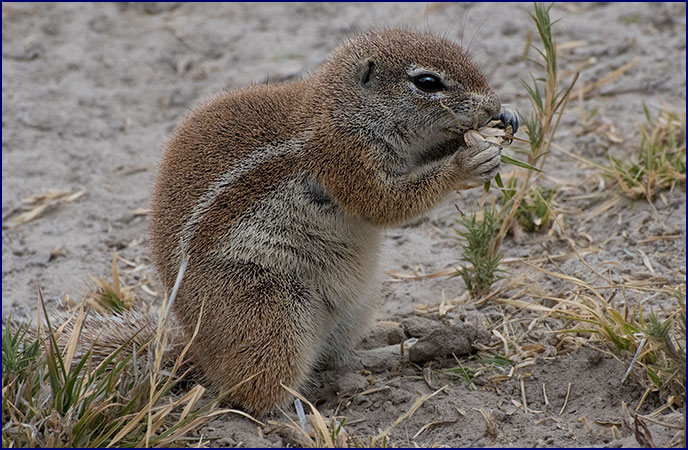
African ground squirrels
|
Glancing over to the other side of the road, there was a
yellow mongoose sitting up peering at us. She had a half-grown
baby with her. She stood up on her hind legs to look around, a lot
like the meerkats (to which she is related), but far more
beautiful. About the same size as the squirrels, the mongoose was
refined and elegant, with a petite face and a pert expression. She
had a yellowish-brown coat with silvery highlights and
chestnut-brown eyes. She stretched and yawned, showing us she had
some impressively sharp little teeth. The baby mongoose curled up
in a tight ball against the cold, trying to sleep.
|
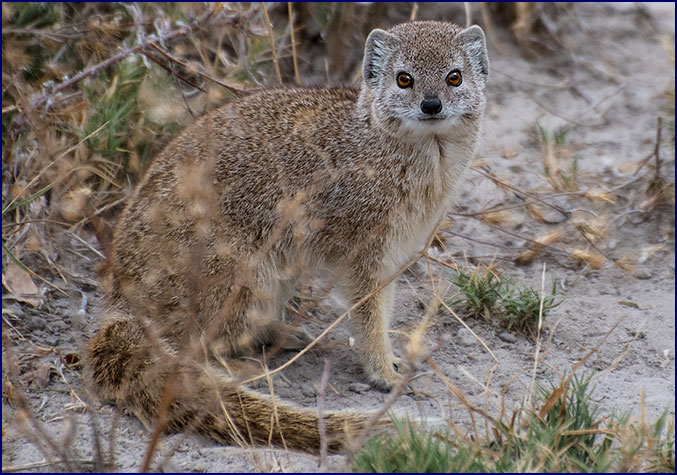
Yellow mongoose
|
After a while the young mongoose woke up, and the mother
greeted him with some face rubbing and kissing. They were joined
by another adult, presumably the father, and there were more
kisses all around. The family apparently lived in harmony with the
ground squirrels.
More wildebeest dashed across the road in front of us,
galloping in a single file row. We got another glimpse of the
springboks in the distance, and asked Jocasta to stop so we could
watch a small group of zebras as they rolled in the sand. Jocasta
often seemed surprised that we wanted to spend so much time
watching animals we had already seen before, or small things like
squirrels, mongoose and terrapins. She may have been more used to
guests who just checked things off their lists and then were in a
hurry to get back to the lodge.
We were back to camp by 11:00, though we would have
preferred to stay out longer. We took showers, had lunch and
relaxed. I found a springbok horn in the bushes not far from the
dining hall - it would be a great souvenir if I could manage to
smuggle it home.
Taking a narrow trail from the
main lodge, Jineen discovered a nice little thatched gazebo under
a twisted tree. It was a pleasant place to relax and read. Pied
crows looked down on us from the tree, occasionally squawking and
flying about.
We were starting to feel restless; having a siesta from
eleven o'clock until four was not really our style. We were
enjoying our time at Camp Kalahari; it was well worth coming to
see the meerkats and the aardvark, to walk with the San people and
see the Makgadikgadi Pan. But on the whole we preferred the mobile
camping safari schedule to that of the lodge. After being in the
bush with Gee and experiencing the wildlife up close and personal,
here it seemed less natural and wild.
Midafternoon, Natalie came and told me there was an
elephant just outside her cabin. I hurried down the trail with her
to see it. Sure enough, a large bull elephant was about fifty feet
from the cabin - so much for the perimeter fence!
He was shaking a palm tree to make
the nuts drop down. He would get up against the tree on his tippy
toes, reach up with his trunk as far as it would go, then grasp
the trunk and give it a good shake. A rain of palm nuts would come
down with a noise like a great wind, and he would eagerly scarf
them up before repeating the process. No wonder the tops got
broken off the palm trees to turn them into telephone poles.
Around four o'clock that
afternoon we set out for a quad bike trip. Jocasta told us to
dress warm, and to bring the scarves that had been provided in the
cabins; we had each been given a long thick cloth called a kiaoi
(pronounced coy). She also suggested that we should bring any
medicines we might need, just in case of emergency, like if our
quad bike broke down. This seemed vaguely alarming; surely we
wouldn’t be stranded out on the pan all night?
We drove in the vehicle out across the plain, passing
ostriches, zebras and springboks on the way. When we got near the
pan we found a long line of four-wheelers waiting for us, fourteen
of them. We each chose one and strapped our cameras and gear on to
it. Everyone from camp was going so there were not quite enough
quad bikes, so Jineen and Natalie shared one.
Jocasta showed us how to wrap the
kiaois around our heads, covering our mouths, noses and hair,
leaving just our eyes showing. It seemed very Arabic!
I felt a little ridiculous, but Tara managed to look quite
stylish in hers.
After a short briefing, we drove out to the pan, staying in
a single file line to protect the environment.
The quad bikes were fun and easy to drive. Clouds of dust
rose from the four-wheelers ahead of us; it was quickly evident
that the kiaois were very useful to keep the dust out of our
faces.
|
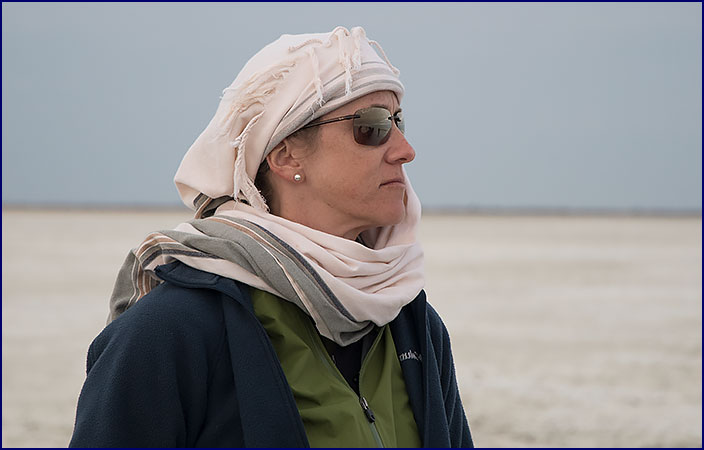
Tara, styling in her kiaoi.
|
We headed out across the
Makgadikgadi Pan. Up
until now we had just seen some of the smaller salt flats around
its edges, but the Makgadikgadi was vast.
There was nothing but white powdery soda dirt as far as you
could see; it looked like the surface of the moon. The flat crusty
salt pan, scattered with a few small rocks, stretched to the
horizon in all directions. The sun was lowering in the sky,
sending gods rays down through the patchy clouds. It was like an
alien world, and it had a strange and eerie beauty.
|
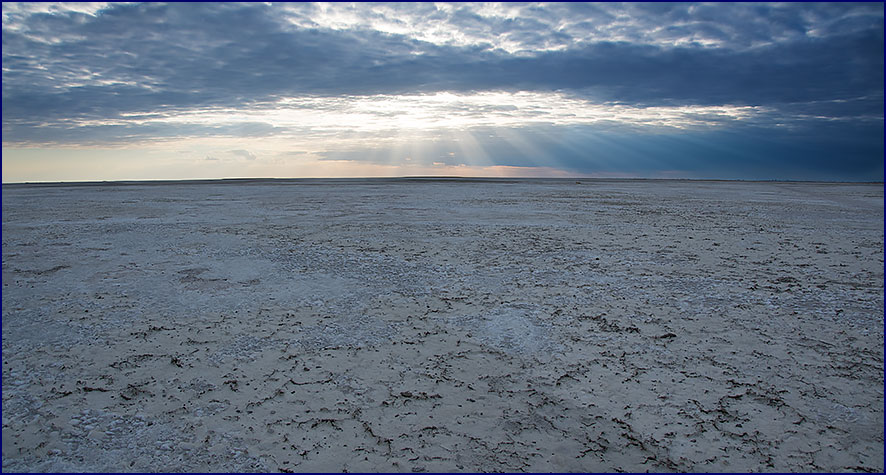
Makgadikgadi
Pan
|
We stopped and parked the quad bikes in a long row. Walking
around a bit, we took some photos and enjoyed the unique
strangeness of the setting. The guides took group photos. Some
people were doing the jumping challenge; we noticed that the
photographer lay flat on the ground in order to shoot upwards –
that low angle must be how you get that ‘floating’ effect.
Next time I would know!
Our group leader was a charismatic man from camp with a
deep resonating voice that sounded like the actor James Earl Jones
(I’ll call him JEJ for short). He had us all play a game: he
placed a backpack out on the pan about 100 yards away; the
challenge was to try to walk a straight line to it - while
blindfolded. He said whoever gets the closest wins the backpack;
then he covered our eyes with a blindfold, one by one. It was way
harder than you might think! We
watched, laughing, as each walker veered off in different
directions, many going in almost a complete circle. JEJ kept up a
commentary; “Oh look, he went all the way to Zimbabwe.” Or,
“She ended up in Victoria Falls.”
Tara prepared methodically,
measuring her paces and practicing hard while the others were
going, determined to walk in a straight line - nonetheless she
went in a big curving arc. Most people took slow careful steps and
still went every which way, so my theory was that if I walked
purposefully and fast I would stay straighter. Didn’t work; I
think I ended up in Namibia. By the time everyone was done, we
were strewn out across the pan in a wide semi-circle. It was very
enlightening.
The sun was nearing the horizon. JEJ told us to go out and
find a private spot all by ourselves and watch the sunset alone,
and enjoy the silence. It was amazingly peaceful. The white crusty
ground turned to a dark blueish grey, and the sky turned to fire
as the sun dropped below the clouds. I picked up a few rocks to
take home.
It was dark by the time we mounted up on the quad bikes. We
drove off across the pan as the last of the sunset colors faded
from the sky, staying in line using the headlights. Before long we
came to a fire; we stopped and parked the bikes in a row again. A
large campfire was blazing, with a circle of folding chairs around
it. A bar had been set up nearby; we got some drinks and sat
around the fire. A bathroom tent had been put up a little ways
across the pan, marked by burning torches, and we could see a
Landcruiser parked nearby with a trailer attached to it.
Presently JEJ told us it was time
to go, and asked us to each carry our chair back to the trailer.
We followed Jocasta through the darkness. Presently we came not to
the trailer, but to a marvelous dinner table, all set up just like
in camp. We were to have dinner on the pan. We put the chairs
around the table, and sat down to a delicious meal. It was a bit
cold, so the staff came around and put hot coals under each chair;
the warmth wafted up from below. Natalie said, “This puts
bushbabies to shame!” But
we did have to watch where we put our feet. Having dinner out on
the pan was fabulous. The only way it could have been better was
if the stars had been out; we felt a bit cheated by the cloudy
sky.
With dinner over it was time to be heading back. But JEJ
told us that before we went back to the lodge there was something
special we needed to see. He explained that the best-preserved
petrified remains of a hippo ever found were nearby, and having
come this far we mustn’t miss visiting the fossil bed. Again we
followed Jocasta through the night, guided by faint moonlight. We
passed the quad bikes parked in a single file row; they reminded
me of a line of wildebeests.
As we looked for the fossil bed,
we could make out a row of dim shapes ahead in the dark. Suddenly
we realized it was a long line of beds. Fossil beds my foot; these
were beds for us to sleep in! We were being invited to spend the
night out on the pan. No wonder Jocasta had said to bring any meds
we might need. Some people were a little annoyed by the deceptive
setup, but I actually enjoyed the surprise factor. Jineen, Natalie
and I decided to stay, but Paula and Tara were worried about being
cold and opted to go back.
The beds were set in groups of two
or three, just like the cabins, with about 100 meters between each
grouping. They had metal bed frames and a rug-like mat beside
them. Each bed had a sheet, a heavy wool blanket and a thick
comforter, and they were enveloped in a heavy canvas zip-up cover
like a giant sleeping bag. Inside was a very fat warm bushbaby.
We needn’t have worried about being cold; the beds were very
warm and cozy.
|
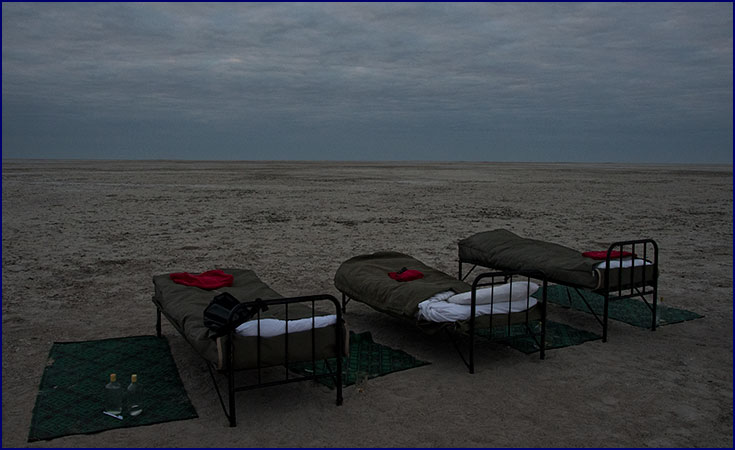
Bedtime on the Makgadikgadi
Pan
|
We visited the bar; Natalie and I got some Amarula, the
liqueur made from the fruit of marula trees, and Jineen chose
wine. We took the drinks back to our beds and sipped them as we
sat and looked out across the pan. A half-moon hung in the sky,
barely visible through the clouds, and the salt pan sort of
shimmered in the ambient light. We could see a glowing cloud to
the south and another fainter one in the east, but we could not
imagine what caused them. UFOs?
Magic? (We
later learned that the brighter cloud glowed from the reflected
light of a diamond mine about 100 kilometers to the south, and the
fainter one to the east was from a salt mine over 150 kilometers
away.)
The night was totally silent.
Sleeping out there was sort of otherworldly, but not at all scary.
It took me a long time to get to sleep and I woke up often, but
Natalie conked out like a light. I woke up in the wee hours and
needed to answer nature’s call. It was a long way through the
dark to the bathroom, but they had told us it was fine to just
walk out on the pan for ‘number one.’ We had each been given a
flashlight, and been instructed to turn it on and hang it on the
bed if we got up in the night, so we could be sure to find our way
back. Remembering our attempts to walk in a straight line while
blindfolded earlier, I was careful not to go too far through the
dark or lose sight of the beds.
The moon went down later; it was
still cloudy, but a couple of stars peeked through. Sleeping out
on the pan was a unique experience, and one I will remember for a
long time. I really
regretted that the sky was cloudy though; sleeping under the Milky
Way and the incredible African stars would have been unbelievable.
August 2
In
the morning we looked out across the pan, the row of beds looking
a bit forlorn in the morning light. We had coffee and tea at the
campfire, and then drove the quad bikes back to the vehicle. We
returned to Camp Kalahari for breakfast, and then showered and
packed, preparing for the first of our four flights home.
I was sad that our trip had come to an end. As we loaded
our bags into the vehicle I muttered something along the lines of
“Oh well, I guess it’s time to get back to the real world.”
JEJ looked at me solemnly and said in a serious tone,
“This IS the real world.” He is right.
I like thinking of it that way. Africa, nature, the
wilderness; all this is
the real world, at least the real world as it used to be, and as
it should be.
|
~
The End ~
|
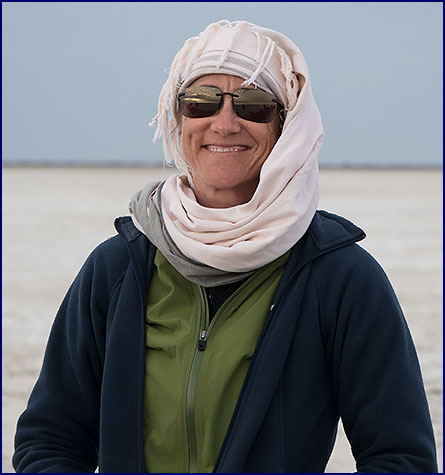
Tara |
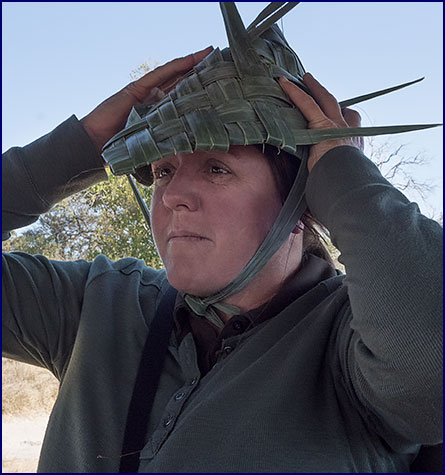
Natalie
|
|
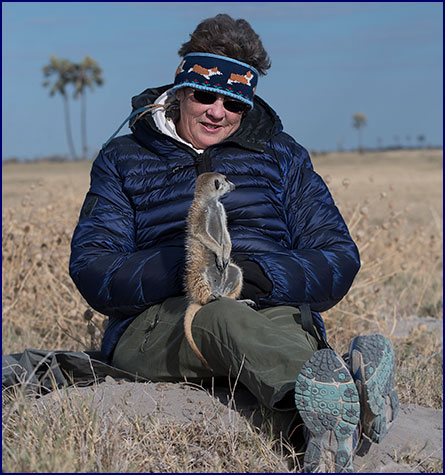
Paula |
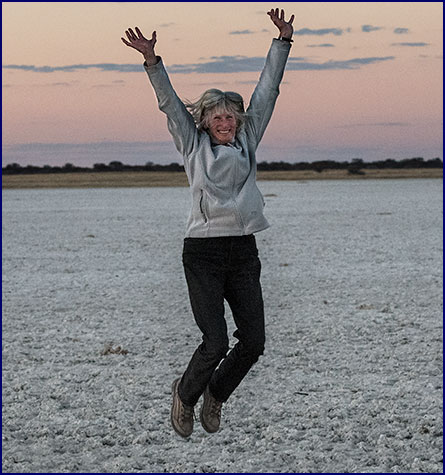
Jineen
|
|
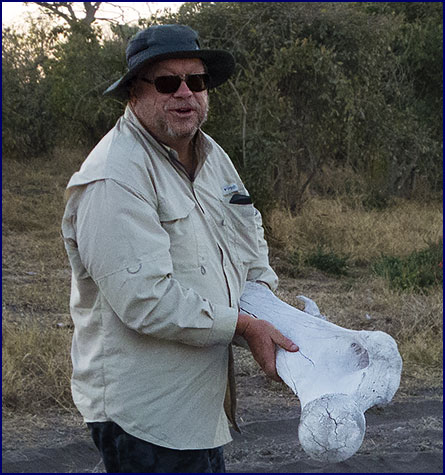
Rob |
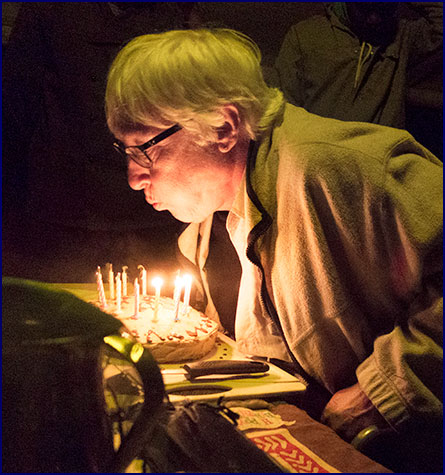
Patty
|
|
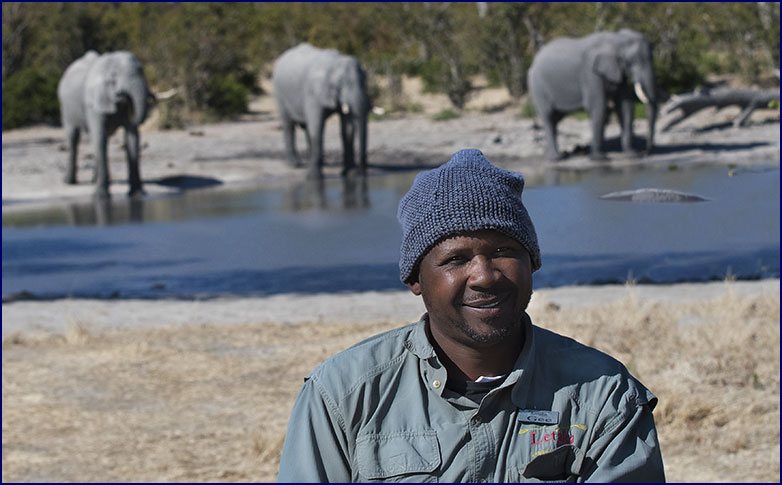
Gee
|
|
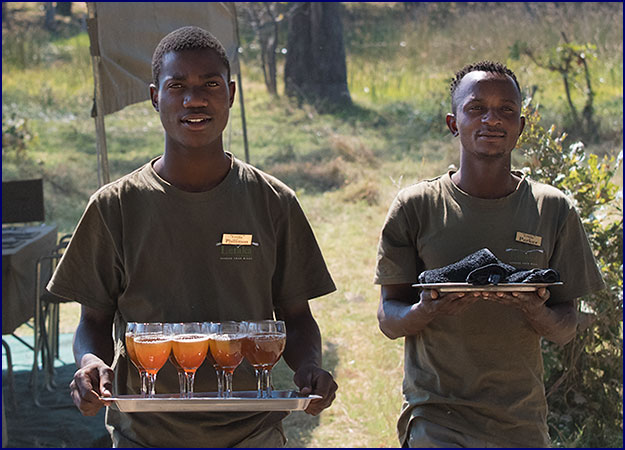
Phillimon
and Parker
|
|
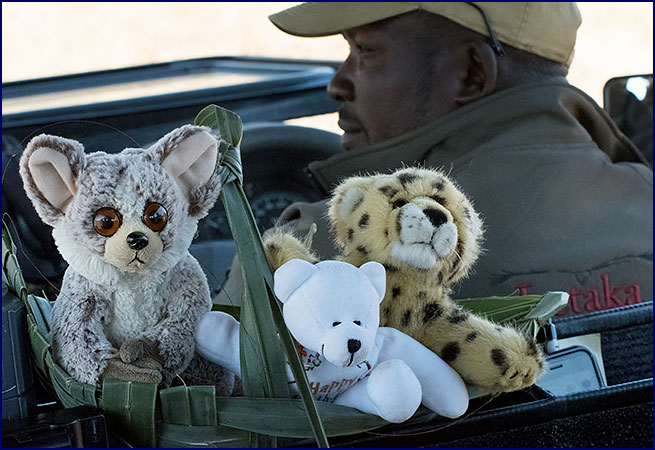
Fred, Birthday
Bear and Duma
|
|
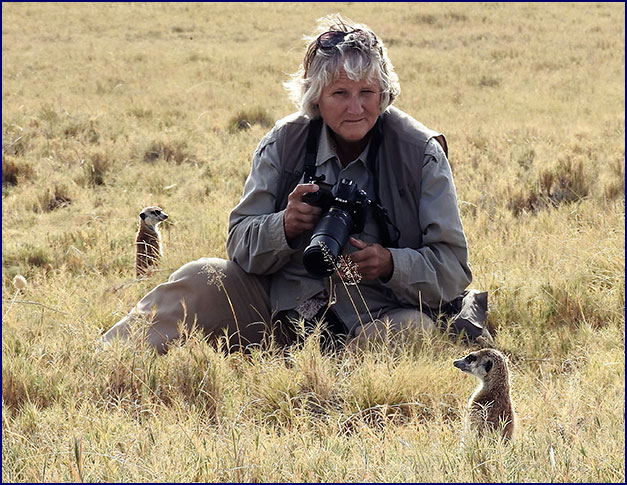
Phyllis
|
Africa
2017 Pages:
1 2
3 4
5 6
7 8 9 10
11 12
13
14
15
Back
to the AFRICA 2017 INDEX Page
|
|